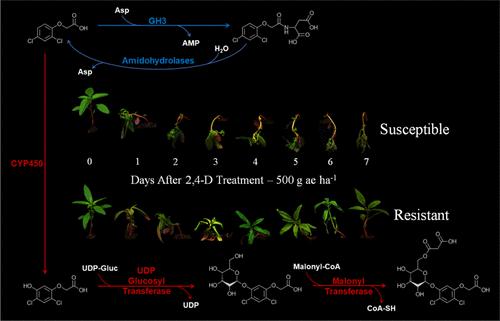当前位置:
X-MOL 学术
›
J. Agric. Food Chem.
›
论文详情
Our official English website, www.x-mol.net, welcomes your
feedback! (Note: you will need to create a separate account there.)
Identification of a Novel 2,4-D Metabolic Detoxification Pathway in 2,4-D-Resistant Waterhemp (Amaranthus tuberculatus)
Journal of Agricultural and Food Chemistry ( IF 5.7 ) Pub Date : 2022-12-01 , DOI: 10.1021/acs.jafc.2c05908 Marcelo R A de Figueiredo 1 , Hamlin Barnes 1 , Claudia M Boot 2 , Ana Beatriz T B de Figueiredo 1 , Scott J Nissen 1 , Franck E Dayan 1 , Todd A Gaines 1
Journal of Agricultural and Food Chemistry ( IF 5.7 ) Pub Date : 2022-12-01 , DOI: 10.1021/acs.jafc.2c05908 Marcelo R A de Figueiredo 1 , Hamlin Barnes 1 , Claudia M Boot 2 , Ana Beatriz T B de Figueiredo 1 , Scott J Nissen 1 , Franck E Dayan 1 , Todd A Gaines 1
Affiliation

|
A 2,4-dichlorophenoxyactic acid (2,4-D)-resistant population of Amaranthus tuberculatus (common waterhemp) from Nebraska, USA, was previously found to have rapid metabolic detoxification of the synthetic auxin herbicide 2,4-D. We purified the main 2,4-D metabolites from resistant and susceptible plants, solved their structures by nuclear magnetic resonance (NMR) and high-resolution mass spectrometry (HRMS), and synthesized the metabolites to determine their in planta toxicity. Susceptible plants conjugated 2,4-D to aspartate to form 2,4-D-aspartic acid (2,4-D-Asp), while resistant plants had a unique metabolic profile where 2,4-D was hydroxylated into 5-OH-2,4-D, followed by conjugation into a sugar metabolite (2,4-D-5-O-d-glucopyranoside) and subsequent malonylation into 2,4-D-(6′-O-malonyl)-5-O-d-glucopyranoside. Toxicological studies on waterhemp and Arabidopsis thaliana confirmed that the hydroxylated metabolite lost its auxinic action and toxicity. In contrast, the 2,4-D-Asp metabolite found in susceptible plants retained some auxinic action and toxicity. These results demonstrate that 2,4-D-resistant A. tuberculatus evolved novel detoxification reactions not present in susceptible plants to rapidly metabolize 2,4-D, potentially mediated by cytochrome P450 enzymes that perform the initial 5-hydroxylation reaction. This novel mechanism is more efficient to detoxify 2,4-D and produces metabolites with lower toxicity compared to the aspartic acid conjugation found in susceptible waterhemp.
中文翻译:

2,4-D 抗性 Waterhemp (Amaranthus tuberculatus) 中新型 2,4-D 代谢解毒途径的鉴定
来自美国内布拉斯加州的结核苋(普通水麻)的 2,4-二氯苯氧乙酸 (2,4- D ) 抗性种群先前被发现对合成生长素除草剂 2,4 -D具有快速代谢解毒作用。我们从抗性和易感植物中纯化了主要的 2,4 -D代谢物,通过核磁共振 (NMR) 和高分辨率质谱 (HRMS) 解析了它们的结构,并合成了代谢物以确定它们在植物中的毒性。易感植物将 2,4- D与天冬氨酸结合形成 2,4- D -天冬氨酸 (2,4-D-Asp),而抗性植物具有独特的代谢特征,其中 2,4- D被羟基化为 5-OH-2,4- D,然后缀合为糖代谢物(2,4 -D -5 - O - d-吡喃葡萄糖苷),随后丙二酰化为 2,4 - D- ( 6'- O -丙二酰基)-5- O - d -吡喃葡萄糖苷。对 waterhemp 和拟南芥的毒理学研究证实,羟基化代谢物失去了其生长素作用和毒性。相反,在易感植物中发现的 2,4 -D- Asp 代谢物保留了一些生长素作用和毒性。这些结果表明,2,4 -D抗性结核放线菌进化出易感植物中不存在的新型解毒反应以快速代谢 2,4 -D,可能由执行初始 5-羟基化反应的细胞色素 P450 酶介导。与易感水麻中发现的天冬氨酸结合相比,这种新机制可以更有效地解毒 2,4-D 并产生毒性更低的代谢物。
更新日期:2022-12-01
中文翻译:

2,4-D 抗性 Waterhemp (Amaranthus tuberculatus) 中新型 2,4-D 代谢解毒途径的鉴定
来自美国内布拉斯加州的结核苋(普通水麻)的 2,4-二氯苯氧乙酸 (2,4- D ) 抗性种群先前被发现对合成生长素除草剂 2,4 -D具有快速代谢解毒作用。我们从抗性和易感植物中纯化了主要的 2,4 -D代谢物,通过核磁共振 (NMR) 和高分辨率质谱 (HRMS) 解析了它们的结构,并合成了代谢物以确定它们在植物中的毒性。易感植物将 2,4- D与天冬氨酸结合形成 2,4- D -天冬氨酸 (2,4-D-Asp),而抗性植物具有独特的代谢特征,其中 2,4- D被羟基化为 5-OH-2,4- D,然后缀合为糖代谢物(2,4 -D -5 - O - d-吡喃葡萄糖苷),随后丙二酰化为 2,4 - D- ( 6'- O -丙二酰基)-5- O - d -吡喃葡萄糖苷。对 waterhemp 和拟南芥的毒理学研究证实,羟基化代谢物失去了其生长素作用和毒性。相反,在易感植物中发现的 2,4 -D- Asp 代谢物保留了一些生长素作用和毒性。这些结果表明,2,4 -D抗性结核放线菌进化出易感植物中不存在的新型解毒反应以快速代谢 2,4 -D,可能由执行初始 5-羟基化反应的细胞色素 P450 酶介导。与易感水麻中发现的天冬氨酸结合相比,这种新机制可以更有效地解毒 2,4-D 并产生毒性更低的代谢物。










































 京公网安备 11010802027423号
京公网安备 11010802027423号